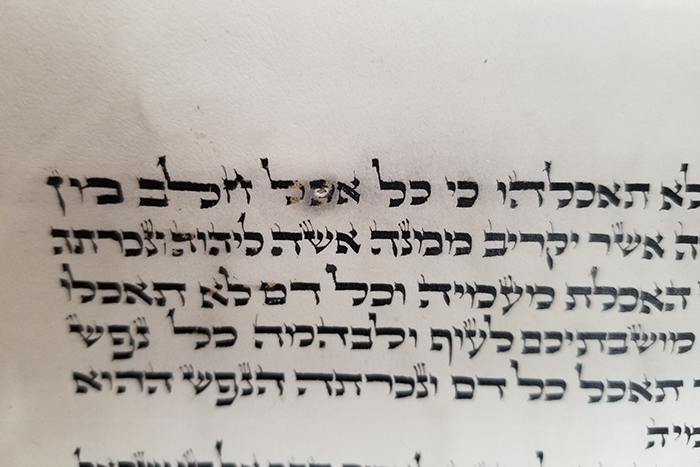
The holiday of Shavuot is coming up, when we celebrate the giving of the Torah at Sinai. It is also a good time to commit ourselves to the physical care of our Torah scrolls. Here are 5 ways to protect Judaism’s holiest objects:
- Don’t touch the letters.
Touching the letters with your hands can cause the ink to smear, which will render the scroll unkosher. Even the the pointer that the Torah reader uses to track their place in the scroll, should not touch the letters, as it can scrape away the ink. Rather, the yad should be held just above the surface of the scroll. If the lectern is too high for the Torah reader, a step to stand on should be provided so that the top of the columns can be read easily without leaning on the parchment (this is also an access need).
- Roll your scrolls regularly and with care.
Try to roll the Torah scroll evenly so that the edges line up with each other; protruding edges get easily worn. Do not roll the parchment too tightly, as this can cause the ink to stick to the facing parchment and flake off. Conversely, don’t roll it too loosely, as this can allow for movement between the sheets of parchment which can rub off letters.
If your congregation has multiple Torah and reads special sections relating to the holiday cycle, such as the reading for Rosh Chodesh, rather than leaving one scroll perpetually rolled to those portions, it is better to rotate between scrolls. Reading from the same section repeatedly causes that section to wear out fast. (Parashat Pinchas, which contains the majority of these special readings, is the most consistently damaged portion of the Torah.)
Jewish tradition teaches that a Torah scroll should be rolled from beginning to end once every month. This is not a conservation matter, but rather one of staying connected with the Torah. When not in the midst of a pandemic, this is a great educational event and a way to involve the community in the care of your sifrei Torah. As you think about your plans for re-opening, consider inviting your members in small groups to come and participate in the rolling of the Torah scrolls as a way of re-establishing a connection between the Torah and the community.
- As best as you can, keep your scrolls in a friendly climate.
While normal temperature variation is usually not a concern, excessive moisture or humidity can cause letters to stick or even run; on the flip side, too little moisture can cause ink to flake off. Equally harmful is insufficient air circulation, which can lead to mold growth. A fully climate-controlled ark is ideal, but not always feasible. Install an inexpensive thermometer in the ark to track humidity. 35%-55% relative humidity is the target climate range. Excessively humid arks can benefit from a container of desiccant; those that are too dry can be helped by a small humidifier, so long as mist does not fall directly on the Torah.
In general, temperatures that are fine for humans are fine for a Torah scroll. However, extreme temperature changes are also not good for a Torah. We would not recommend taking your Torah outside in extreme temperatures or on high humidity days.
- What to do when you find a problem.
When you find a problem with a scroll, put it aside immediately; continuing to use it after a problem is identified can exacerbate damage. Take a picture of the problem area and send it to a scribe. This will help the scribe assess the problem, give you a more accurate quote on what the repair will cost, and assemble the correct supplies ahead of time for the necessary repair.
Placing sticky notes on the scroll to mark problems can cause additional damage. In fact, do not mark the scroll in any way, even with pencil. Also, do not attempt to repair tears with any kind of tape, as this will result in further damage when the tape is removed.
- Be proactive about Torah maintenance.
Just like a car or a building, it’s easier to fix problems if you catch them early rather than waiting until they get to a critical point. Torah scrolls might not need annual checkups, but a check of your scrolls every few years can save a lot of headache and money down the road.
Scroll checkups can be bundled with other services for an efficient use of everyone’s time and money. In addition to checking scrolls, scribes can teach educational sessions for both children and adults. When fixing the problems discovered during the check, a very popular option is to hold a Torah writing fundraising event, where members can sponsor letters or words and participate in their writing (these kinds of events have good return on investment, rendering the scribe’s visit revenue-neutral or even revenue-positive).
For more information.
For more information about Torah maintenance, please reach out to us. Stam Scribes is here to help.
Stam Scribes is a collective of progressive Jewish scribes from all over the world. Providing a variety of services for individuals and Jewish communities, including writing new Torah scrolls, repairing Torah scrolls, writing and illustrating , repair, and education.
Styles of observance vary from scribe to scribe, but we are all committed to the Jewish scribal tradition, fostering excitement about Judaism through a scribal lens, and a strict code of professional and personal ethics.
Wishing you a joyous celebration of the giving of the Torah. Chag sameach.
Related Posts

For Small Congregations: Adult Learning and Purim Celebration

Awakening to the Moral Imperatives of this Moment
